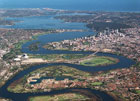The Waugul

To the Noongar traditional owners and custodians, Western Australia’s Swan River, the Derbal Yerrigan has remained at the heart of their culture and heritage for more than 40,000 years. Aboriginal people cared for the land and its waters as an integral part of their spirit and culture prior to the arrival of Europeans. They would have seen periods of climate change and sea level rises. They lived in harmony with their land and waters, firing the bush, crossing the River, camping along the River banks, getting water from springs, hunting and fishing.
Mythologically the River was created by the Waugals (giant serpents), who carved waterways and valleys as they made their way to the mouth of the river at Fremantle. Noongar people have a responsibility to protect and care for the land and its waters as an integral part of their spirit and culture.
Noel Nannup writes about Boorloo, the Nyungar name for Perth and the Derbal Yerrigan (the Swan River):
"Boorloo had a series of lakes and big mobs of kwulla, the mullet, would come up from the sea around March to lay their eggs in the shallows where they wouldn’t be disturbed. Also the Swan River, we call it the Derbal Yerrigan. Now the word derbal, to my knowledge, means mixing; because it is where you have the sweet water and the salt water coming together, especially near the islands at Burswood. That is where you have got your tidal movement. Water flows under there too…" [2]
The traditional owners of the land were deeply connected with the River. The Aboriginal people themselves came from the creation beings that created life and imparted knowledge and law. Len Collard describes the powerful Rainbow Serpent:
"The Waakal is the creator, the keeper of the freshwater sources. He gave us life and our trilogy of belief in the boodjar – the land – as our mother and nurturer of the Nyungar moort – family and relations – and our katitjin Law – knowledge so that we could weave the intricate tapestry known as the ‘web of life’." [3]
The Waugal has also been described as easing and coiling his way down the Swan River:
"Creating the bends in the river at Belmont and Maylands as he went. Before he reached the islands at the Causeway, he rattled his skin, shaking all the scales off in the mud as he wrestled to gain access to Perth Water. When he finally emerged through the Narrows, he made another big coil to create the open expanse of water downstream of the Narrows. Waugal then ascended Mount Eliza through a gap in the limestone cliffs, by way of the small valley or stormwater gully situated behind where the Swan Brewery Stables were built." [4]
Page last updated: Tuesday 23 November 2010 by Nick Cowie Asset ID 12468
Editors for this page nick 2nd account
login




